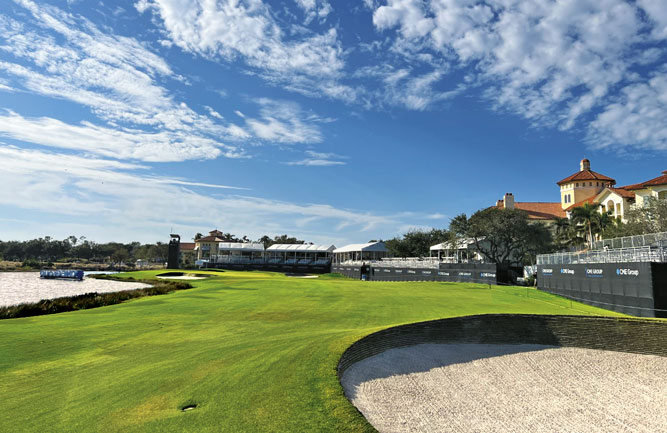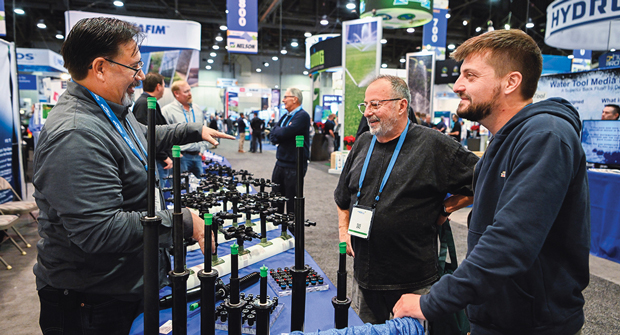Studies show successful dormant bermudiagrass sprigging in Transition Zone
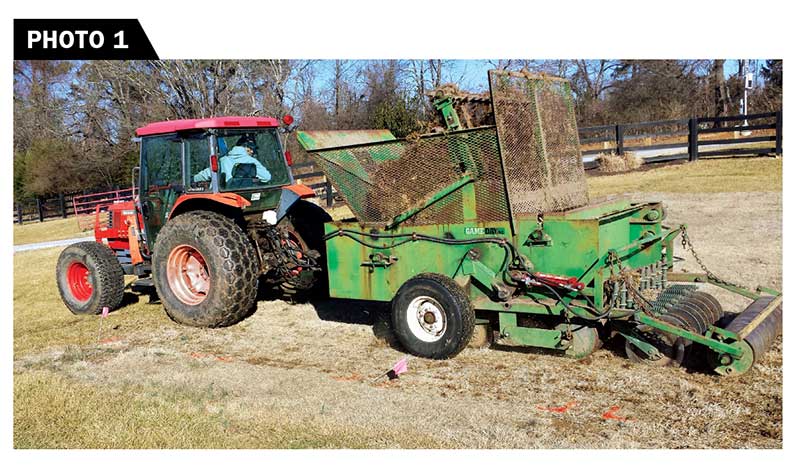
Latitude 36 sprigs were row-planted in January 2018 at the Virginia Tech Turfgrass Research Center in Blacksburg, Va. (Photo by: Mike Goatley, Ph.D.)
The Transition Zone of the United States is located in USDA-ARS Plant Hardiness Zones 6 to 8, where both cool-season and warm-season grasses are grown but not without concern for their performance and survival because of extreme environmental conditions.
Establishing bermudagrass from vegetative stems (sprigs) during the standard planting times of midspring through to midsummer in the Transition Zone requires regular and frequent moisture after planting, essentially prohibiting the establishment of these grasses where supplemental irrigation is unavailable.
Latitude 36 hybrid bermudagrass provides desirable playing surfaces for golf courses in the Transition Zone because of its cold tolerance and exceptional density. Dormant sprigging would allow superintendents to take advantage of the time of year with reduced outdoor maintenance labor and fewer golfers using the course. If successful, dormant establishment might allow for earlier golf course use. The success of dormant sprigging may be limited by extreme cold or dry conditions, though there are few validated experiments in the literature.
The objectives of this research were to (a) evaluate the establishment success of four planting months (January, February, March and April) to determine if the planting date affected the time required to reach a target of 90 percent bermudagrass ground cover and (b) to determine if the use of a translucent turf blanket and/or a surface application of compost (0.25-inch depth) at sprigging enhanced sprig establishment.
Dormant sprigging experiment
Field studies were conducted from January through July in 2017 and 2018 at the Virginia Tech Turfgrass Research Center in Blacksburg, Va. Glyphosate (5 pounds AI per acre) was applied with a CO2 pressurized sprayer delivering 40 gallons per acre spray volume to the research sites in the fall preceding each year’s dormant sprigging establishment site to control all existing vegetation.
The underlying soil was not tilled and was left fallow until winter sprigging. The soil used for the trials was a Groseclose loam with 3.8 percent organic matter and a pH of 6.3. The Virginia Tech Soil Testing Lab performed soil tests that indicated that all nutrient levels were sufficient, so no additional nutrients were applied except for nitrogen.
The experimental layout was a 3×4 factorial, split-plot design with whole plots being the monthly planting dates of January, February, March and April each year. An April planting date was included in both years’ trials, although April-planted sprigs failed in 2018; therefore, the data gathered for the April 2017 sprigging date were excluded from this report.
Latitude 36 hybrid bermudagrass sprigs were harvested 18 to 24 hours in advance of planting from the production fields of Oakwood Sod Farm (Delmar, Md.) and were installed during the respective planting months by a commercial contractor (Game Day, Chantilly, Va.) with a custom row-planting machine at a sprigging rate of approximately 800 bushels per acre. Our physical count of stems distributed by the machine observed this planting rate to deliver around 25 sprigs per feet2. Immediately before planting, oxadiazon was applied at 4 pounds AI per acre as a preemergence herbicide to suppress weed seed germination.
Within the 6-by-24-foot whole plots (sprigging month), four 6-by-6-foot subplots were arranged in a randomized complete block across four replications with treatments of a surface application of a commercially available composted cow manure (Black Kow, Black Gold Compost Co., Oxford, FL; 0.5–0.5–0.5 N– P2O5–K2O) at a 0.25-inch depth, an Evergreen (EG) turf blanket (Covermaster, Rexdale, Ontario, Canada), a combination of the compost and EG and an uncovered control.
Natural precipitation was the only moisture received by the plots during the trial. The EG blankets were removed from the treatments on May 10 in both years. This date is approximately one week after the average frost-free date at this location, and we wanted to initiate regular nitrogen fertilization and mowing of the bermudagrass.
As establishment progressed, postemergence applications of foramsulfuron at 0.4 ounces AI per acre and quinclorac at 32 pounds AI per acre were applied for weed control in mid-May of both years with a CO2 pressurized sprayer delivering 40 gallons per acre spray volume.
The plots were fertilized with water-soluble nitrogen urea (46–0–0 N–P–K) at 39 pounds N per acre monthly from mid-May through mid-July, and there was no adjustment of nutrient levels for plots that did not receive compost. Mowing was initiated after removing the blanket treatments in mid-May, with all the plots clipped to 1.5 inches twice weekly with a rotary mower and all clippings returned to the turf.
A 90 percent bermudagrass coverage (BC90) rating was chosen as the required establishment threshold for turfgrass density that would be acceptable for use as a golf turf fairway. The percentage of green cover within subplots was assessed weekly beginning in mid-May after blanket removal with Canopeo version 2.0 application software (4). Canopeo was calibrated on a nearby mature stand of Latitude 36 bermudagrass to establish a baseline of 100 percent cover. Data collection continued until 90 percent turf coverage was achieved within the subplot treatments.
Bermudagrass cover was modeled over time, beginning at the point of turf blanket removal and until BC90 was achieved within subplot treatments by nonlinear regression. The number of weeks to reach BC90 was determined by custom inverse prediction of the Gompertz equation (JMP, Version 15. SAS Institute, Cary, N.C., 1989–2021). The equation parameters were used to estimate initial bermudagrass green coverage following turf blanket removal on May 10 of each year.
Environmental conditions during establishment
Departures in monthly precipitation totals for 2017 and 2018 during the January to June study periods were compared against the 50-year monthly historical averages for January to June (Figure 1). Monthly rainfall totals were highly variable across the two seasons, with notably low rainfall totals of 0.8 inch in February 2017 and 1.5 inches in January 2018.
Rainfall totals were close to average in March of each year, above average for April and May and below average in June of each year. A proposed advantage of dormant sprigging in the Transition Zone is to utilize naturally occurring winter and spring precipitation events to provide enough moisture to establish sprigs in nonirrigated settings successfully.
A concern with dormant sprigging was expected to be damage or death of sprigs because of the likelihood of extremely cold temperatures after planting. Figure 2 details the departure from the monthly 50-year average high and low temperatures for the duration of the trials in 2017 and 2018. The three planting months detailed (January, February and March) all had average lows below freezing, and the departures from average varied greatly within months and years.
January 2018 had particularly below-average temperatures, with an average low temperature of 17 degrees F for these trials, whereas February’s average high and low temperatures were well above the average each year (9). The lowest single-day temperatures were recorded in January for both years at −0.9 degrees F for 2017 and 5 degrees F for 2018 (9). February had single-event low temperatures of 12.9 degrees F in 2017 and 10 degrees F in 2018 (data not shown) (U.S. Climate Data, 2021a).
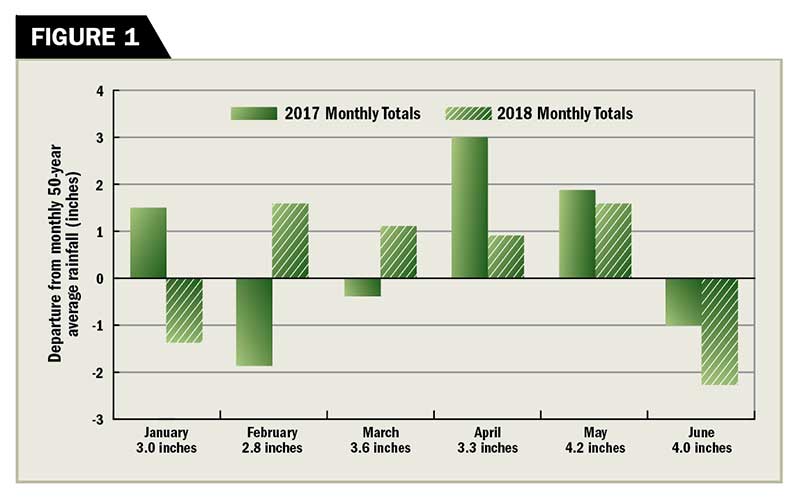
Departure in monthly rainfall totals (inches) for the duration of the 2017 and 2018 dormant bermudagrass establishment trials from 50-year monthly rainfall averages as per U.S. Climate Data (2021a, 2021b). (Graphic: Golfdom Staff)
Dormant sprigging results
Treatment differences of bermudagrass canopy coverage were significant (P ≤.05) for some data collection dates by planting month, cover treatment (blanket and/or compost), year and their interactions. Annual precipitation and temperature contributed to yearly interactions. For instance, rainfall totals for January and February in each year were highly variable, either above or below the 50-year averages (Figure 1). In 2018, average high and low temperatures for February were higher than those for March (Figure 2).
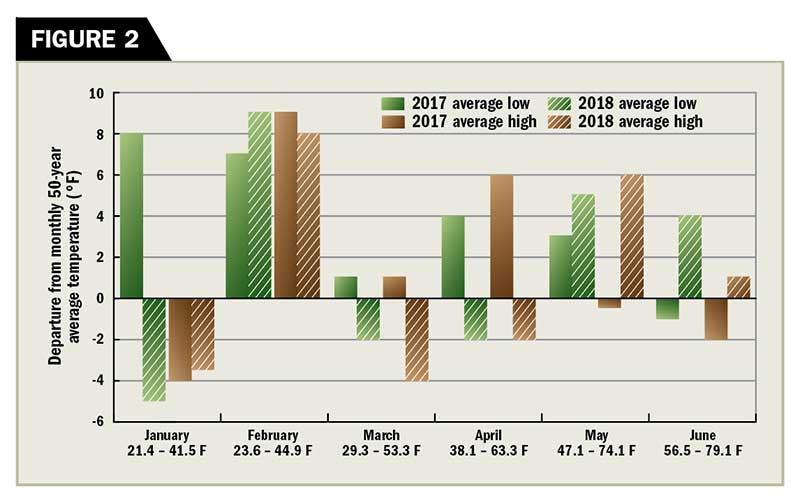
Departure in monthly rainfall totals (inches) for the duration of the 2017 and 2018 dormant bermudagrass establishment trials from 50-year monthly rainfall averages as per U.S. Climate Data (2021a, 2021b). (Graphic: Golfdom Staff)
Planting month and cover treatment impacted initial bermudagrass coverage but had no long-lasting impact on establishment. Therefore, data were modeled using a four-parameter nonlinear regression to estimate bermudagrass coverage influenced by both factors. The coefficient of determination was high for both planting month (r2 ≥ 0.80) and for cover treatment (r2 ≥ 0.80), making it an appropriate model for estimating bermudagrass coverage over time (Table 1 and Table 2).
Although bermudagrass coverage was influenced by sprigging month for some early assessments, differences in coverage ratings were small (<10 percent) and were not considered of practical importance to the end user. Estimated initial bermudagrass coverage (range: 25 to 29 percent) after turf blankets were removed was not influenced by sprigging month (Table 1). Similarly, the time required to reach BC90 was 4.7 to 5 weeks after blankets were removed in May, regardless of the initial sprigging month.
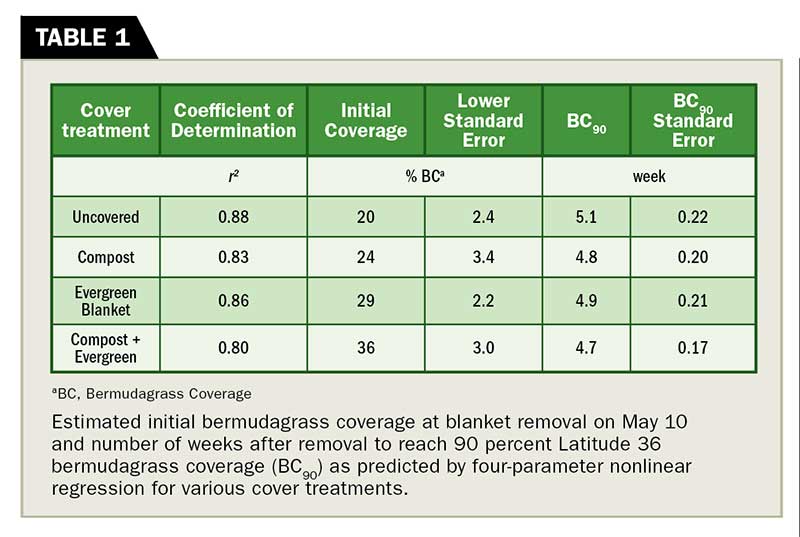
(Graphic: Golfdom Staff)
Sprig cover treatments influenced initial bermudagrass coverage when turf blankets were removed but had no long-term impact on establishment through to the study’s conclusion (Table 2). The EG turf blankets alone and in combination with compost increased initial bermudagrass coverage after removal by 9 and 16 percent, respectively. The addition of compost alone did not enhance initial green bermudagrass coverage. The estimated time to reach BC90 was approximately five weeks after blanket removal, regardless of cover treatment at sprigging.
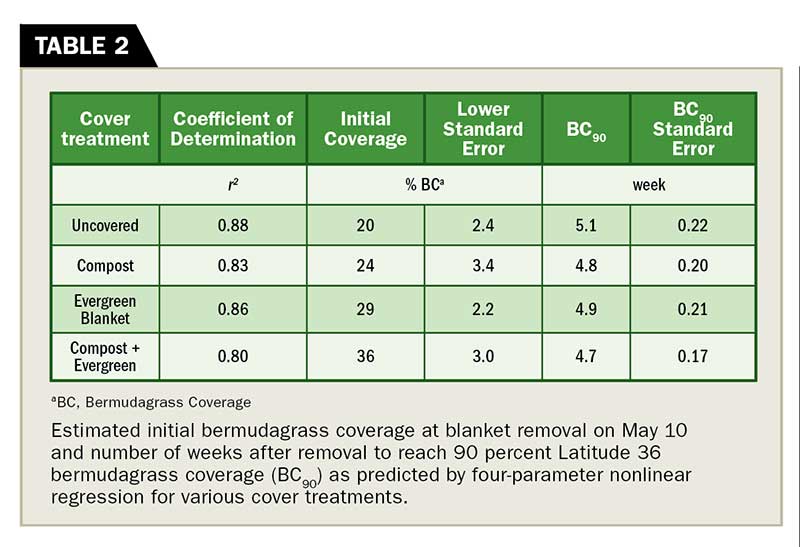
(Graphic: Golfdom Staff)
The cover treatment responses as determined by bermudagrass coverage were not impacted by the variability in winter moisture in these studies in Blacksburg, Va. In this experiment, the initial growth impacts of the blanket and/or compost treatments on bermudagrass establishment were short-lived. The temporary improvement had no long-term biologically significant implications on bermudagrass establishment. However, we expect that leaving the EG blankets in place beyond May 10 would have continued to accelerate bermudagrass greening based on previously reported spring bermudagrass greening responses to blankets from (1). Other research reported negative effects on turf growth from surface-applied compost treatments, but we observed no visible response in bermudagrass coverage from the addition of compost (7). Further research with compost topdressings is warranted because of the highly variable physical and chemical aspects of compost sources.
Possible concerns with the earliest planting dates in our research trials include more prolonged periods in the field for the sprigs to be exposed to environmental extremes in temperature, moisture, possible wash or movement from the soil and increased weed pressure arising from the loss of preemergence herbicide residual activity.
Previous research in Texas under irrigated conditions indicated that sprig survival in winter establishments was affected by severe cold (5). A concern observed in our study was the inconsistency in bermudagrass establishment across both years from an April sprigging date. Our analysis excluded these data because of an April 2018 establishment failure. We hypothesize that an extreme weather event compromised sprig viability just before sprig harvest at that time.
Weather data for the sod farm that provided the sprigs indicated dramatic temperature fluctuations at their site before the sprig harvest in 2018. The high air temperature on April 4 was 75 degrees F, and bermudagrass was mainly green and actively growing (Gary Wilber, owner of Oakwood Sod Farm, personal communication, 2018). However, with extremely cold temperatures followed by the nighttime low on April 5 reaching 0 degrees F (10), it is possible that the dramatic drop in temperature damaged the grass in the area that was harvested for sprigs.
The same plant material source that failed in the April 2018 establishment was planted in another research trial at the nearby Virginia Tech golf course. The similar failure at both sites suggests that sprig viability might be a concern for planting success, especially when sprig harvests are made during transitional periods from winter dormancy to active growth.
Golf courses in locations with suitable temperature and moisture levels for dormant grass establishment might be able to take advantage of earlier establishment techniques, particularly if supplemental irrigation is required for a standard late spring/early summer establishment. Future research evaluating different bermudagrass cultivars and dormant sprigging establishment versus standard bermudagrass planting dates is needed, as well as studies to evaluate establishment success potential in climates with seasonal temperature and moisture expectations that differ from those of this region of the Transition Zone.
Acknowledgments
The authors acknowledge the support of Game Day (Chantilly, Va.) for its custom bermudagrass row-planting services, Oakwood Sod Farm (Salisbury, Md.) for providing the sprigs, Covermaster (Ontario, Canada) for the turf blankets and the Virginia Agricultural Experiment Station. Mention of trade names or commercial products in this publication solely provides specific information and does not imply a Virginia Agricultural Experiment Station recommendation.
Article adapted from Herrmann M., Goatley J., McCall D., Askew S. Establishment of dormant Latitude 36 bermudagrass sprigs in the Transition Zone. Crop, Forage & Turfgrass Mgmt. 2021;7:e20087.









